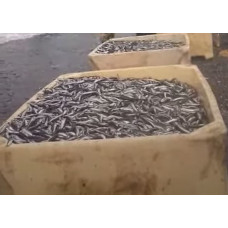Capelin (Mallotus villosus) is a fish of the capelin genus, the smelt family. Elongated body, scales are very small. The lateral line goes up to the vertical end of the anal fin. The mouth is large, armed with small teeth. Schooling marine, mesopelagic fish. It lives in the northern parts of the Atlantic, Arctic and Pacific Oceans. It forms two subspecies, the Atlantic capelin (Mallotus villosus villosus) and the Far Eastern capelin (Mallotus villosus socialis). Matures in the first to fourth year of life, fertility from 6.2 to 11.9 thousand eggs. Caviar is small, bottom, sticky. It feeds on zooplankton, worms, fish eggs. Capelin feeds on large fish (cod) and marine mammals — whales, seals. Commercial fish.
Body length up to 25 cm, weight up to 52 g, maximum lifespan 10 years. Capelin has very small scales and small teeth. The back is olive-greenish, the sides and belly are silvery. Males are distinguished by the presence on the sides of a strip of scales, on each of which there is a kind of pile.
Capelin is distributed almost circularly, in the Arctic and the northern parts of the Atlantic and Pacific Oceans. It is found: in the North Atlantic — the Barents Sea to Bear Island, the Norwegian Sea to Spitsbergen, the coast of Greenland (up to 74 ° C.) and from Hudson Bay to the Gulf of Maine (USA); in the North Pacific — to Korea and Vancouver Island (Canada). Sakhalin Island, Russia.
The name of the fish goes back to the Baltic-Finnish source - cf. Finnish maiva ‘grouse (Coregonus albula)’, ‘small fish’, ‘fry’, ‘bait fish’, Finnish maima ‘small fish used as bait’, Karelian maima ‘bait’, ‘fry’, ‘small fish’, Vepsian maim ‘small dried fish’, ‘small fish', Estonian maima ‘small fry', Livvikov maimu ‘dried small fish, sushchik’, ‘small fish’, Ludikov maim ‘small fry, small fish (live or dried)’, ‘bait fish’.
Gregarious pelagic fish; feeds on planktonic crustaceans, making serious competition with herring and juvenile salmon. Capelin is a purely marine species, lives in the open sea, in the upper layers of water (up to 300 m, less often 700 m).
It approaches the shores only during the spawning period, sometimes even entering estuaries of rivers. Before breeding, capelin gathers in huge shoals that begin to approach the shores. In different parts of its range, it spawns at different times, from spring to autumn. Shoals of capelin going to spawn are followed by flocks of cod, seagulls, seals and even whales. In strong winds, waves throw spawning capelin ashore: in the Far East, the coastal strip is sometimes covered with a layer of capelin thrown out by the surf for many kilometers. Spawning grounds are located on sandy soils, on shoals and banks almost from the water's edge. Fecundity of 1.5—60 thousand eggs; bottom caviar, sticking. The eggs are light yellow, 0.5-1.2 mm in diameter. The larvae hatch after 55 days at a water temperature of 0 ° C and after 8 days at 12 ° C; the current carries them into the open sea. The spawned capelin again departs to the open sea. Spawning is usually 1, rarely 2 times in a lifetime; a lot of capelin die after spawning. Capelin ripens in 2-3 years; males are a year later than females.
Capelin
Tags: capelin




